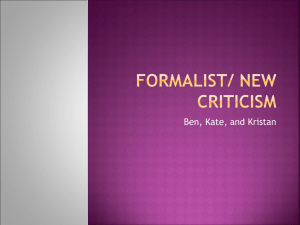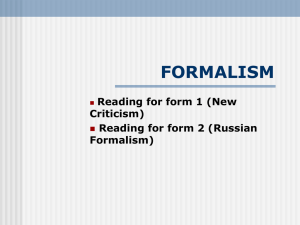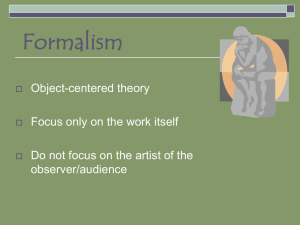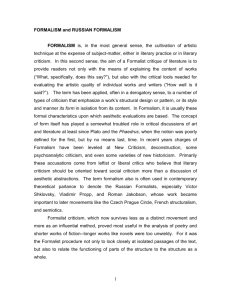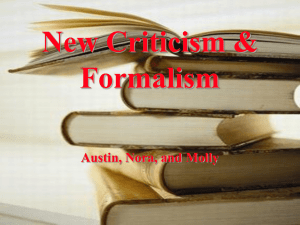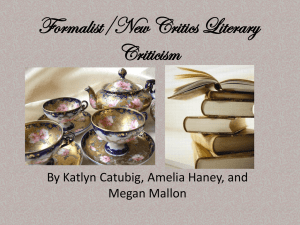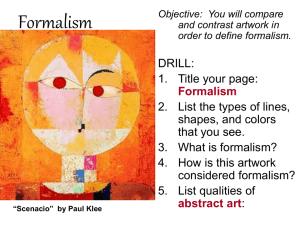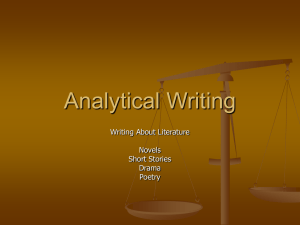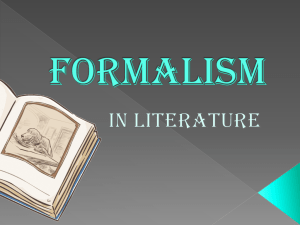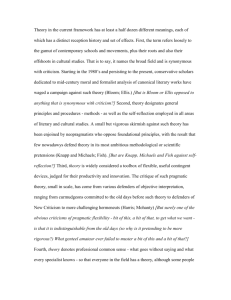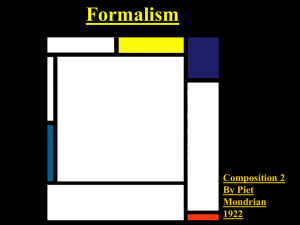What is literature
advertisement
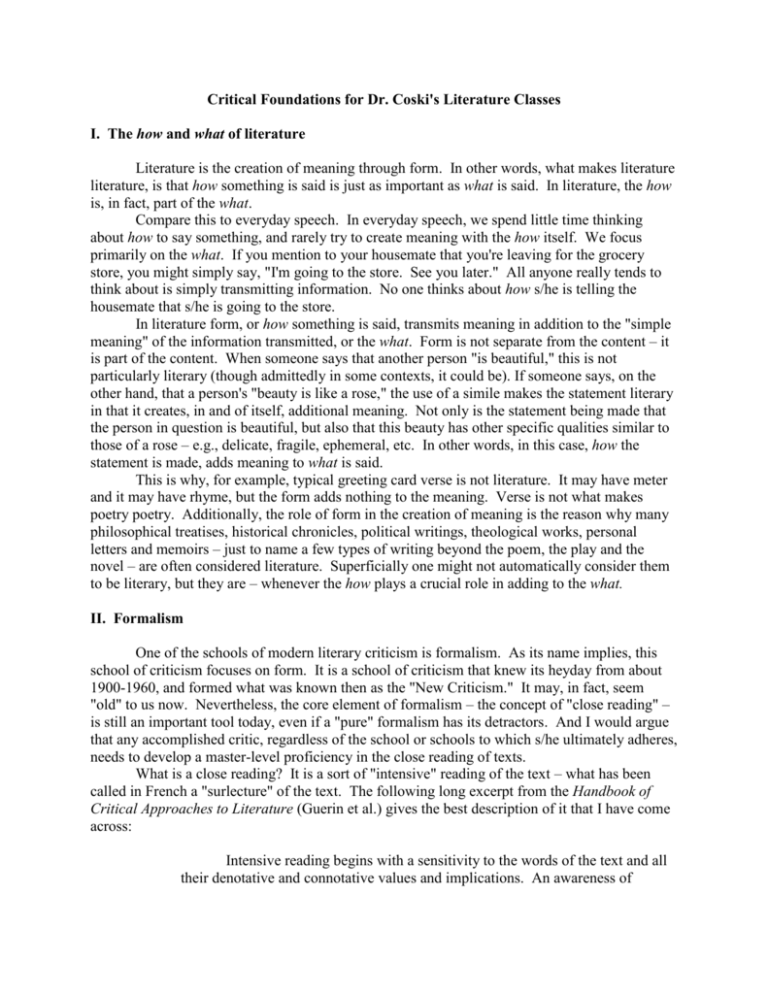
Critical Foundations for Dr. Coski's Literature Classes I. The how and what of literature Literature is the creation of meaning through form. In other words, what makes literature literature, is that how something is said is just as important as what is said. In literature, the how is, in fact, part of the what. Compare this to everyday speech. In everyday speech, we spend little time thinking about how to say something, and rarely try to create meaning with the how itself. We focus primarily on the what. If you mention to your housemate that you're leaving for the grocery store, you might simply say, "I'm going to the store. See you later." All anyone really tends to think about is simply transmitting information. No one thinks about how s/he is telling the housemate that s/he is going to the store. In literature form, or how something is said, transmits meaning in addition to the "simple meaning" of the information transmitted, or the what. Form is not separate from the content – it is part of the content. When someone says that another person "is beautiful," this is not particularly literary (though admittedly in some contexts, it could be). If someone says, on the other hand, that a person's "beauty is like a rose," the use of a simile makes the statement literary in that it creates, in and of itself, additional meaning. Not only is the statement being made that the person in question is beautiful, but also that this beauty has other specific qualities similar to those of a rose – e.g., delicate, fragile, ephemeral, etc. In other words, in this case, how the statement is made, adds meaning to what is said. This is why, for example, typical greeting card verse is not literature. It may have meter and it may have rhyme, but the form adds nothing to the meaning. Verse is not what makes poetry poetry. Additionally, the role of form in the creation of meaning is the reason why many philosophical treatises, historical chronicles, political writings, theological works, personal letters and memoirs – just to name a few types of writing beyond the poem, the play and the novel – are often considered literature. Superficially one might not automatically consider them to be literary, but they are – whenever the how plays a crucial role in adding to the what. II. Formalism One of the schools of modern literary criticism is formalism. As its name implies, this school of criticism focuses on form. It is a school of criticism that knew its heyday from about 1900-1960, and formed what was known then as the "New Criticism." It may, in fact, seem "old" to us now. Nevertheless, the core element of formalism – the concept of "close reading" – is still an important tool today, even if a "pure" formalism has its detractors. And I would argue that any accomplished critic, regardless of the school or schools to which s/he ultimately adheres, needs to develop a master-level proficiency in the close reading of texts. What is a close reading? It is a sort of "intensive" reading of the text – what has been called in French a "surlecture" of the text. The following long excerpt from the Handbook of Critical Approaches to Literature (Guerin et al.) gives the best description of it that I have come across: Intensive reading begins with a sensitivity to the words of the text and all their denotative and connotative values and implications. An awareness of multiple meanings, even the etymologies of words as traced in dictionaries, will offer significant guidelines to what the work says. . . . So first let us look at the words and the sentences in which we find them, and let us be alert. But just as we begin to study closely the words and their meanings, almost simultaneously we must also begin to look for structural relationships and patterns – not just in the words and their relationships, but also in larger units. Form becomes much more than sentence patterns; it becomes the relationship of stanzas in a poem, or the interplay of an octave and a sestet in a sonnet. It becomes the tone or mood that the text builds, and possibly the shifting and alternating moods. It becomes the sequence of plot elements, even episodes, in a narrative, or the juxtaposition of scenes in a play. It becomes the relationship between the teller of the narrative and the hearer, possibly the ambiguity of the teller's version of the story. So let us assume now that we have some degree of knowledge of the words of the text, at least in their denotative senses. Let us also assume that we can mentally plot out the sequence of actions, or of sequences and shifting of what the words seem to be telling us. Now we can note that some of these words are deeply connotative also, or perhaps they name objects that have symbolic value, and as we probe the connotations and symbols they take on associations, or develop patterns that somehow have relevance within themselves and to other patterns. Images emerge as more and more important, perhaps insistently forcing themselves to the fore. We note that certain images, or colors, or references to time – a host of possibilities in our human experience – keep coming up. Some of these may contribute to the setting of the work, its actual place and time, or more subtly, its ambience. Bit by formal bit, we think we begin to see a theme emerging from the work. None of this is happening in any set sequence. It is more like when we walk into a room new to us, crowded with people, furniture, art works, a fire in the hearth. How do we see things? How do our eyes move across the scene? What do we see first, what next? In the printed text perhaps the next thing is an allusion that has caught our attention, a reference to a bit of history or mythology, or to another work of literature. Maybe a word has taken on more than one meaning, causing us to read the text at more than one level; or we suspect that there is irony developing in what we see, and we become suspicious that first impressions need modification. Or details of a narrative seem especially vivid or striking, but not yet clearly important as we move through the plot's complication – and then, suddenly perhaps, the narrative reaches a climactic point, and all details fall into place by the point in the narrative that we sometimes call the dénouement. Then there is a sense of closure, a sense of fulfillment of the expectations that have been built up. What did the author do by so arranging those words, those images and symbols, those details of plot and action? How did the author "achieve" this accomplishment? . . . In retrospect, we can say that what the author did was to make us see that internal relationships gradually reveal a form, a principle by which all subordinate patterns can be accommodated and accounted for. When all the words, phrases, metaphors, images, and symbols are examined in terms of each other and of the whole, any literary text worth our efforts will display its own internal logic. When that logic has been established, the reader is very close to identifying the overall form of the work. So . . . what must we do to make ourselves close readers in a formalistic way? . . . we shall look for . . . structure, shape, interplay, interrelationships, denotations and connotations, contexts, images, symbols, repeated details, climax (rising action, falling action), dénouement, balances and tensions, rhythms and rhymes that catch our attention, sounds that do the same, the speaker's apparent voice, a single line – or even a word – set off all by itself. Whatever, in other words, contributes to the uniqueness of the work. (74-76) In the end, the close reading prescribed by formalism is an approach to literature that has at its foundation, the preoccupation for the relationship between the how and the what of literature described above. III. Beyond Formalism – internal and external readings There is of course a danger in a "pure" formalist reading of any text in that such a reading tends to divorce the text from its context. In other words, a purely formalist approach tends to look at a text from the "boundary" of the text inward, treating the text as an autonomous item, disconnected from the world around it. And indeed, formalism's critics have argued that such a pure formalism does not truly illuminate us. On the other hand, ignoring the formal elements of literature fails to acknowledge the very literariness of the text (the how being essential to the what, in any literary text). A better approach lies using the fruits of a formalistic close reading as the basis for then looking at how the work fits into some larger context. In other words, first we look from the "boundary" of the text inward, and then we look from the "boundary" of the text outward, and try to see how the two views relate to each other. We need to make ties between the analysis results and real-life issues surrounding the text: psychological, cultural, social, political, philosophical, historical, feminist, gender-based, sexual, minority-related or other. Then the close reading, by combining the internal with the external, takes on real critical meaning and expands our understanding of the text. For a sample of this, go to the following web page: http://oak.cats.ohiou.edu/~coski/advanced.html and click on the link to "Sample Text Analysis."
